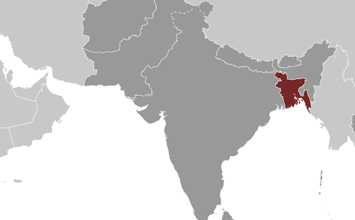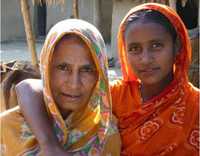
CDC has been collaborating with Bangladesh for the past 40 years—most recently to strengthen the country’s capacity to detect emerging infectious diseases and to provide training and other interventions to partners. In 2012, CDC designated Bangladesh as a CDC Global Disease Detection Center for enhancing global health security for rapid detection and response to infectious diseases.
Download Overview Fact Sheet
 Bangladesh at a Glance
Bangladesh at a Glance
Population: 166,208,7120
Per capita income: $2,100
Life expectancy at birth women/men: 68/72 yrs
Infant mortality rate: 45/1000 live births
Central Intelligence Agency, The World Factbook, 2014
 Top 10 Causes of Death
Top 10 Causes of Death
Source: GBD Compare, 2010
- Cancer 13%
- Lower Respiratory Infections 7%
- Chronic Obstructive Pulmonary Disease 7%
- Ischemic Heart Disease 6%
- Stroke 5%
- Preterm Birth Complications 4%
- Tuberculosis 3%
- Neonatal Encephalopathy 3%
- Diabetes 3%
- Cirrhosis 3%
What CDC Is Doing
- Page last reviewed: August 14, 2014
- Page last updated: August 14, 2014
- Content source:
Global Health
Notice: Linking to a non-federal site does not constitute an endorsement by HHS, CDC or any of its employees of the sponsors or the information and products presented on the site.



 ShareCompartir
ShareCompartir

 CDC works collaboratively with icddr,b and Bangladesh's National Tuberculosis Programme to better characterize the transmission and treatment of TB and drug-resistant TB in Bangladesh. Research activities, focused on improving prevention and treatment efforts, currently include ongoing surveillance of drug-resistant TB at 14 sites across the country, an investigation of hospital-acquired TB transmission, and evaluations of two TB program activities: hospital-based TB infection control and a new nationwide model for community-based treatment of multi-drug-resistant TB.
CDC works collaboratively with icddr,b and Bangladesh's National Tuberculosis Programme to better characterize the transmission and treatment of TB and drug-resistant TB in Bangladesh. Research activities, focused on improving prevention and treatment efforts, currently include ongoing surveillance of drug-resistant TB at 14 sites across the country, an investigation of hospital-acquired TB transmission, and evaluations of two TB program activities: hospital-based TB infection control and a new nationwide model for community-based treatment of multi-drug-resistant TB. CDC works in close collaboration with icddr,b and MOHFW to train public health personnel and to develop the capacity of local junior scientists to become independent health science researchers. CDC supported the establishment of the Bangladesh Field Epidemiology Training Program (FETP) in 2013 (see section below) and provides support for two icddr,b staff who are seconded to IEDCR to assist with the management of outbreak investigations. At Icddr,b , approximately 35 Bangladeshi scientists are currently working on CDC-supported projects. CDC also supports the Centre for Communicable Diseases' Training Support Group at icddr,b , which conducted 59 training courses in 2013 on a wide variety of topics that included scientific writing, statistical analysis, clinical epidemiology, training of rapid response teams, and FETP courses.
CDC works in close collaboration with icddr,b and MOHFW to train public health personnel and to develop the capacity of local junior scientists to become independent health science researchers. CDC supported the establishment of the Bangladesh Field Epidemiology Training Program (FETP) in 2013 (see section below) and provides support for two icddr,b staff who are seconded to IEDCR to assist with the management of outbreak investigations. At Icddr,b , approximately 35 Bangladeshi scientists are currently working on CDC-supported projects. CDC also supports the Centre for Communicable Diseases' Training Support Group at icddr,b , which conducted 59 training courses in 2013 on a wide variety of topics that included scientific writing, statistical analysis, clinical epidemiology, training of rapid response teams, and FETP courses.